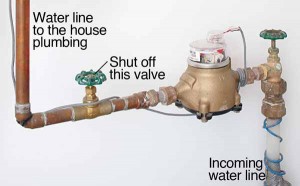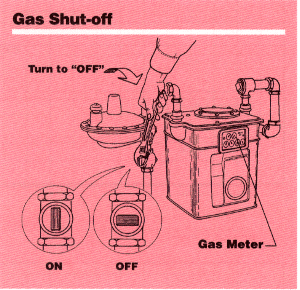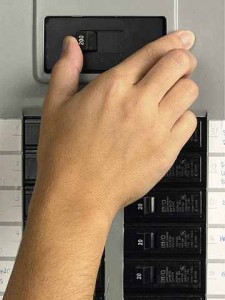by Nick Romaniello -
“Shut ‘er down!”
While knowing where your home’s utility shut-offs are located may seem like common knowledge — I routinely run into homeowners who have no idea where they are or how to operate them, so I feel it should be addressed. If you are already familiar with your home’s shut-offs then this is an opportunity to brush up (or share with your other family members). Most on-grid homes utilize three basic utilities: Electric, Gas and Water. While most of the pipes and wires hiding in the basement should be left to the professionals, knowing how to shut off each of your utilities in an emergency is your responsibility. The place and method for which they enter your home vary from one municipality to another, so take the time to familiarize yourself with your area’s specifics. Call your local utility company, a plumber, or electrician if you have specific questions; but I will address the basics here.
Water
 Water generally enters the home from underground to prevent the lines freezing in winter. The water meter will usually be located in a basement, or utility room, and will have a shut-off on each side of the meter to allow the water utility to easily change the unit. The shut-off will usually be either a lever, or a knob, or possibly one of each. Operating the shut-off on either side of the meter will stop the flow of water throughout the house. Hard water can corrode shut-offs that have not been operated in years so it’s a good idea to regularly make sure your water shut-offs are in operating condition. If they are stuck in the on position they must be replaced immediately. A non-functioning shut-off is a major hazard and should not be ignored.
Water generally enters the home from underground to prevent the lines freezing in winter. The water meter will usually be located in a basement, or utility room, and will have a shut-off on each side of the meter to allow the water utility to easily change the unit. The shut-off will usually be either a lever, or a knob, or possibly one of each. Operating the shut-off on either side of the meter will stop the flow of water throughout the house. Hard water can corrode shut-offs that have not been operated in years so it’s a good idea to regularly make sure your water shut-offs are in operating condition. If they are stuck in the on position they must be replaced immediately. A non-functioning shut-off is a major hazard and should not be ignored.
Gas
 Your gas meter may be located inside or outside your home, as natural gas is not affected by freezing. Gas meter shut-offs do not have handles or valves since they are not intended to be regularly operated by home owners. The gas meter will require a wrench to operate. Usually an adjustable wrench will work, but some meters use specialty wrenches; find out what your meter uses before hand and keep it near the meter. Following natural disasters (i.e. earthquakes, tornadoes, hurricanes) many devastating fires are fueled by ruptured gas lines, so shutting off your natural gas can help prevent home damage from becoming total home loss. ONLY shut off your natural gas service in an emergency. Once it is off all of your pilot lights will go out; turning the gas back on without proper knowledge and equipment could release natural gas into your home and become deadly.
Your gas meter may be located inside or outside your home, as natural gas is not affected by freezing. Gas meter shut-offs do not have handles or valves since they are not intended to be regularly operated by home owners. The gas meter will require a wrench to operate. Usually an adjustable wrench will work, but some meters use specialty wrenches; find out what your meter uses before hand and keep it near the meter. Following natural disasters (i.e. earthquakes, tornadoes, hurricanes) many devastating fires are fueled by ruptured gas lines, so shutting off your natural gas can help prevent home damage from becoming total home loss. ONLY shut off your natural gas service in an emergency. Once it is off all of your pilot lights will go out; turning the gas back on without proper knowledge and equipment could release natural gas into your home and become deadly.
Electric
 Depending on the age of your home you will either have a fuse box (older) or breaker box (newer). A breaker or fuse (often placed at the top and away from others inside the box) should be labeled as ‘main’. To disconnect electricity either flip this breaker or remove this fuse. If you have fuses, consider contacting an electrician about upgrading to breakers for convenience and added safety.
Depending on the age of your home you will either have a fuse box (older) or breaker box (newer). A breaker or fuse (often placed at the top and away from others inside the box) should be labeled as ‘main’. To disconnect electricity either flip this breaker or remove this fuse. If you have fuses, consider contacting an electrician about upgrading to breakers for convenience and added safety.
Take the time now to locate all of your utility shut-offs and be sure that they are not obstructed. Being able to access them in a hurry or in the dark may be necessary. Shutting off your utilities during a natural disaster, or before an evacuation, can add a layer of protection against possible utility-fueled fires, floods, or explosions should your home sustain damage. There are many variations that I couldn’t cover in a single article so be sure to take time to learn your particular system or consult a professional if you are unsure.

Here is a helpful tool for most households:
http://www.amazon.com/4-in-1-Emergency-Tool/dp/B001CSCC7I/ref=pd_sbs_indust_1
4 and 1 emergency tool.
Pingback: Book Review: Prepper’s Home Defense « preppernextdoor